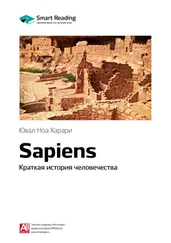When humans domesticated fire, they gained control of an obedient and potentially limitless force. Unlike eagles, humans could choose when and where to ignite a flame, and they were able to exploit fire for any number of tasks. Most importantly, the power of fire was not limited by the form, structure or strength of the human body. A single woman with a flint or fire stick could burn down an entire forest in a matter of hours. The domestication of fire was a sign of things to come.
Our Brothers’ Keepers
Despite the benefits of fire, 150,000 years ago humans were still marginal creatures. They could now scare away lions, warm themselves during cold nights, and burn down the occasional forest. Yet counting all species together, there were still no more than perhaps a million humans living between the Indonesian archipelago and the Iberian peninsula, a mere blip on the ecological radar.
Our own species, Homo sapiens , was already present on the world stage, but so far it was just minding its own business in a corner of Africa. We don’t know exactly where and when animals that can be classified as Homo sapiens first evolved from some earlier type of humans, but most scientists agree that by 150,000 years ago, East Africa was populated by Sapiens that looked just like us. If one of them turned up in a modern morgue, the local pathologist would notice nothing peculiar. Thanks to the blessings of fire, they had smaller teeth and jaws than their ancestors, whereas they had massive brains, equal in size to ours.
Scientists also agree that about 70,000 years ago, Sapiens from East Africa spread into the Arabian peninsula, and from there they quickly overran the entire Eurasian landmass.
When Homo sapiens landed in Arabia, most of Eurasia was already settled by other humans. What happened to them? There are two conflicting theories. The ‘Interbreeding Theory’ tells a story of attraction, sex and mingling. As the African immigrants spread around the world, they bred with other human populations, and people today are the outcome of this interbreeding.
For example, when Sapiens reached the Middle East and Europe, they encountered the Neanderthals. These humans were more muscular than Sapiens, had larger brains, and were better adapted to cold climes. They used tools and fire, were good hunters, and apparently took care of their sick and infirm. (Archaeologists have discovered the bones of Neanderthals who lived for many years with severe physical handicaps, evidence that they were cared for by their relatives.) Neanderthals are often depicted in caricatures as the archetypical brutish and stupid ‘cave people’, but recent evidence has changed their image.
According to the Interbreeding Theory, when Sapiens spread into Neanderthal lands, Sapiens bred with Neanderthals until the two populations merged. If this is the case, then today’s Eurasians are not pure Sapiens. They are a mixture of Sapiens and Neanderthals. Similarly, when Sapiens reached East Asia, they interbred with the local Erectus, so the Chinese and Koreans are a mixture of Sapiens and Erectus.
The opposing view, called the ‘Replacement Theory’ tells a very different story – one of incompatibility, revulsion, and perhaps even genocide. According to this theory, Sapiens and other humans had different anatomies, and most likely different mating habits and even body odours. They would have had little sexual interest in one another. And even if a Neanderthal Romeo and a Sapiens Juliet fell in love, they could not produce fertile children, because the genetic gulf separating the two populations was already unbridgeable. The two populations remained completely distinct, and when the Neanderthals died out, or were killed off, their genes died with them. According to this view, Sapiens replaced all the previous human populations without merging with them. If that is the case, the lineages of all contemporary humans can be traced back, exclusively, to East Africa, 70,000 years ago. We are all ‘pure Sapiens’.
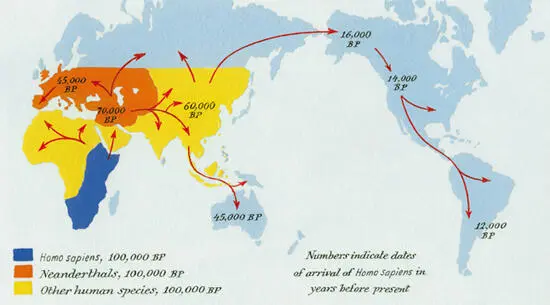
Map 1. Homo sapiens conquers the globe.
A lot hinges on this debate. From an evolutionary perspective, 70,000 years is a relatively short interval. If the Replacement Theory is correct, all living humans have roughly the same genetic baggage, and racial distinctions among them are negligible. But if the Interbreeding Theory is right, there might well be genetic differences between Africans, Europeans and Asians that go back hundreds of thousands of years. This is political dynamite, which could provide material for explosive racial theories.
In recent decades the Replacement Theory has been the common wisdom in the field. It had firmer archaeological backing, and was more politically correct (scientists had no desire to open up the Pandora’s box of racism by claiming significant genetic diversity among modern human populations). But that ended in 2010, when the results of a four-year effort to map the Neanderthal genome were published. Geneticists were able to collect enough intact Neanderthal DNA from fossils to make a broad comparison between it and the DNA of contemporary humans. The results stunned the scientific community.
It turned out that 1–4 per cent of the unique human DNA of modern populations in the Middle East and Europe is Neanderthal DNA. That’s not a huge amount, but it’s significant. A second shock came several months later, when DNA extracted from the fossilised finger from Denisova was mapped. The results proved that up to 6 per cent of the unique human DNA of modern Melanesians and Aboriginal Australians is Denisovan DNA.
If these results are valid – and it’s important to keep in mind that further research is under way and may either reinforce or modify these conclusions – the Interbreeders got at least some things right. But that doesn’t mean that the Replacement Theory is completely wrong. Since Neanderthals and Denisovans contributed only a small amount of DNA to our present-day genome, it is impossible to speak of a ‘merger’ between Sapiens and other human species. Although differences between them were not large enough to completely prevent fertile intercourse, they were sufficient to make such contacts very rare.
How then should we understand the biological relatedness of Sapiens, Neanderthals and Denisovans? Clearly, they were not completely different species like horses and donkeys. On the other hand, they were not just different populations of the same species, like bulldogs and spaniels. Biological reality is not black and white. There are also important grey areas. Every two species that evolved from a common ancestor, such as horses and donkeys, were at one time just two populations of the same species, like bulldogs and spaniels. There must have been a point when the two populations were already quite different from one another, but still capable on rare occasions of having sex and producing fertile offspring. Then another mutation severed this last connecting thread, and they went their separate evolutionary ways.
It seems that about 50,000 years ago, Sapiens, Neanderthals and Denisovans were at that borderline point. They were almost, but not quite, entirely separate species. As we shall see in the next chapter, Sapiens were already very different from Neanderthals and Denisovans not only in their genetic code and physical traits, but also in their cognitive and social abilities, yet it appears it was still just possible, on rare occasions, for a Sapiens and a Neanderthal to produce a fertile offspring. So the populations did not merge, but a few lucky Neanderthal genes did hitch a ride on the Sapiens Express. It is unsettling – and perhaps thrilling – to think that we Sapiens could at one time have sex with an animal from a different species, and produce children together.
Читать дальше
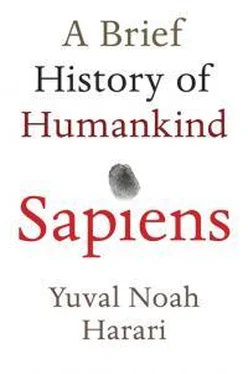

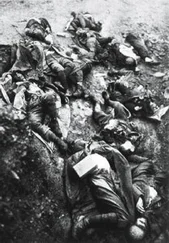

![Юваль Ной Харари - Sapiens. Краткая история человечества [litres]](/books/34310/yuval-noj-harari-sapiens-kratkaya-istoriya-cheloveche-thumb.webp)



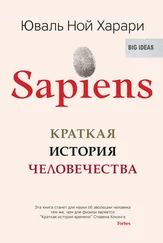

![Юваль Ной Харари - 21 урок для XXI века [Версия с комментированными отличиями перевода]](/books/412481/yuval-noj-harari-21-urok-dlya-xxi-veka-versiya-s-ko-thumb.webp)


